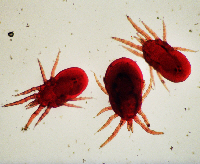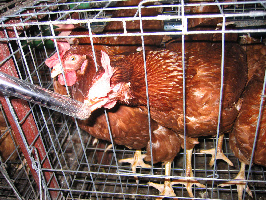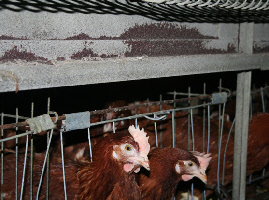



Enigma of the Red Poultry Mite
Greater priority should be given to the eradication of red mites on poultry farms, according to Serbian researchers, A. Pavlicevic (AVES Inc. in Palic), I. Pavlovic (Scientific Veterinary Institute in Belgrade) and Natasa Pavlicevic (Specialist Veterinary Institute in Subotica).
(Image: A. Pavlicevic)

(Image: M. Zekovic, M. Sabonia and A. Pavlicevic)
The body of a bird, covered in feathers, is an ideal environment for hosting external parasites. Therefore, life of birds in free nature could not be imagined without the co–habitation with ectoparasites. Regardless of this, birds’ lives are rarely endangered. Basically, birds live undisturbed. The preconditions for balance have a crucial role in that matter.
In the modern poultry industry, the birds are less able to defend themselves against parasites and unable to leave overburdened habitats while large flocks of birds are accommodated in virtually constant environmental conditions with hidden area that provide excellent living conditions for red mites. Many and numerous populations of Dermanyssus gallinae exert enormous selective pressure and intensively adjust to attempts for control imposed by Man. Mites possess biological traits that have enabled them to thrive on Earth for hundreds of millions of years, with minor adjustments. D. gallinae has effortlessly exploited the new opportunity that we created for it.
The prevalence of chicken red mite is now as follows; for example, in China, 64.1 per cent (Wang et al., 2010), in Italy, Serbia, Morocco, Japan, Montenegro, Netherlands, 80 to 90 per cent (Sparagano et al., 2009) while some regions of Poland show as much as 100 per cent (Cencek, 2003).
Have we taken the correct approach to control D. gallinae? In the majority of cases, red mites have been controlled by the non–expert use of various compounds. Without sufficient understanding of the toxicological aspects, this approach has not worked and the mites remain highly prevalent.
What next? Suppression (reduction) of the red mite can be achieved and brings a temporary improvement but one must take into account the costs of regular treatments as well as possible complications arising from appropriate actions, inadequate exercise of control, choosing the wrong compound or growing resistance.
The fact that the chicken red mite is a vector of type A avian influenza virus serves as a particular warning of possible complications of this dangerous zoonotic disease. Yet even a small population of D. gallinae can be a vector for the transmission of infection. Even disinfection may not be totally effective. After the flocks has been depopulated and the house thoroughly emptied, washed and disinfected, a clean swab result means little if viral and bacterial diseases linger in the red mite population to be spread to the next flock (Moro et al., 2005).
It is impossible in practice to re–create the conditions in which the domestic chicken’s ancestors lived but greater priority should be given to a programme to eradicate red mites on poultry farms using all possible biosecurity measures consistently. A successful programme will achieve this aim.
 |
 |
right: Heavy infectation of red mites on the cage front
(Images: A. Pavlicevic)
References
Cencek, T. (2003) Prevalence of Dermanyssus gallinae in poultry farms in Silesia region in Poland. Bull. Vet. Inst. Pulawy, 47:465-469.
Erlanngung des Grades (2011). Rote Vogelmilbe, Dermanyssus gallinae De Geer 1778, ein experimentell nachgewiesener mechanischer Vektor von Influenza A-Virus und Versuche zur Bekämpfung der Roten Vogemilbe mit einem Phenolderivat. Inaugural-Dissertation. Die Deutsche Bibliothek verzeicnet diese Publikation in der Deutschen Nationalbibliografie.
Sparagano, O.A.E., Pavlicevic, A., Murano, T., Camarda, A., Sahibi, H., Kilpinen, O., Mul, M., van Emous, R., le Bouquin, S., Hoel, K. and Cafiero, M.A. 2009. Prevalence and key figures for the poultry red mite Dermanyssus gallinae infections in poultry farm systems. Exp. Appl. Acarol., 48:3-10
Wang, F.F., Wang M., Xu, F.R., Liang D.M. and Pan, B.L. 2010. Survey of prevalence and control of ectoparasites in caged poultry in China. Veterinary Record, 167:934-937.
Moro, V.C., Chauve C. and Zenner L. 2005. Vectorial role of some Dermanyssoid mites (Acari, Mesostigmata, Dermanyssoidea). Parasite, 12:99-109.
April 2012








